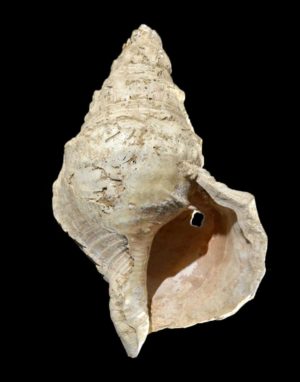
CNRS—Almost 80 years after its discovery, a large shell from the ornate Marsoulas Cave in the Pyrenees has been studied by a multidisciplinary team from the CNRS, the Muséum de Toulouse, the Université Toulouse – Jean Jaurès and the Musée du quai Branly – Jacques-Chirac (1): it is believed to be the oldest wind instrument of its type. Scientists reveal how it sounds in a study published in the journal Science Advances on 10th February 2021.
The Marsoulas Cave, between Haute-Garonne and Ariège, was the first decorated cave to be found in the Pyrenees. Discovered in 1897, the cave bears witness to the beginning of the Magdalenian (2) culture in this region, at the end of the Last Glacial Maximum. During an inventory of the material from the archaeological excavations, most of which is kept in the Muséum de Toulouse, scientists examined a large Charonia lampas (sea snail) shell, which had been largely overlooked when discovered in 1931.
The tip of the shell is broken, forming a 3.5 cm diameter opening. As this is the hardest part of the shell, the break is clearly not accidental. At the opposite end, the shell opening shows traces of retouching (cutting) and a tomography scan has revealed that one of the first coils is perforated. Finally, the shell has been decorated with a red pigment (hematite), characteristic of the Marsoulas Cave, which indicates its status as a symbolic object.
To confirm the hypothesis that this conch was used to produce sounds, scientists enlisted the help of a horn player, who managed to produce three sounds close to the notes C, C-sharp and D. As the opening was irregular and covered with an organic coating (3), the researchers assume that a mouthpiece was also attached, as is the case for more recent conches in collection of the Musée du quai Branly – Jacques Chirac. 3D impressions of the conch will enable this lead to be explored and verify whether it can be used to produce other notes.
The first carbon-14 dating of the cave, carried out on a piece of charcoal and a fragment of bear bone from the same archaeological level as the shell, provided a date of around 18,000 years. This makes the Marsoulas conch the oldest wind instrument of its type: to date, only flutes have been discovered in earlier European Upper Palaeolithic contexts; the conches found outside Europe are much more recent.
In addition to immersing us in the sounds produced by our Magdalenian ancestors, this shell reinforces the idea of exchanges between the Pyrenees and the Atlantic coast, more than 200 kilometers away.
___________________________

At 31 cm in height, 18 cm in diameter (at the widest point) and up to 0.8 cm thick, this conch, which bears witness to a colder sea, is thus larger and thicker than more recent ones. © Carole Fritz et al. 2021.
___________________________

Reconstruction of the instrument being played. In the background, a red dotted buffalo decorates the walls of the Marsoulas Cave; similar motifs decorate the instrument. © Carole Fritz et al. 2021 / drawing: Gilles Tosello
___________________________
– Listen to the sound of the Marsoulas conch: https:/
– See the 3D model: https:/
___________________________
Article Source: CNRS news release
___________________________
Advertisement





